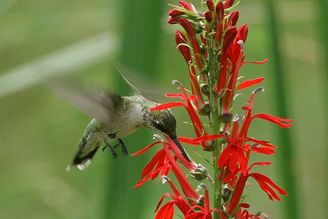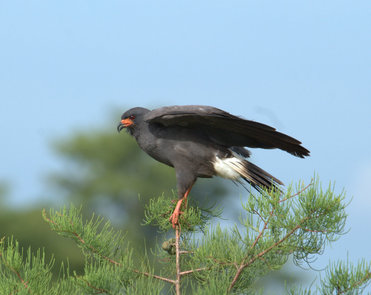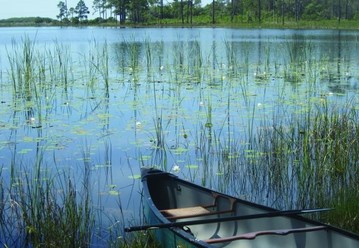 Ruby-throated Hummingbird enjoying a quick sip at a cardinal flower. Photo by Bill Buchanan, USFWS
We love getting outside to the many beautiful sites on the Great Florida Birding and Wildlife Trail, but what about the days we can’t get away from work and home? Luckily, if you start looking, nature can be found everywhere – even in your own backyard!
Did you know that one of the best ways to attract birds to your yard is to plant native species that create habitat and provide food? Hummingbirds love to drink from beautiful nectar-rich flowers, and birds such as cardinals, buntings, chickadees, doves, grosbeaks and more will gobble up seeds from native wildflowers. Plants also provide habitat for insects that will attract less common backyard birds, such as migrating warblers! In addition to providing a refuge for birds, planting native species in your backyard can attract beautiful butterflies and important pollinator species. On top of all these benefits for wildlife, a backyard landscaped with native plants is a beautiful sanctuary for you and your family!
For more information on landscaping with native plants, check out Florida Fish and Wildlife Conservation Commission’s Plant a Refuge for Wildlife guide, or take a look at the Florida Wildflower Foundation website! You can also learn more about wildlife in your own backyard from Florida Nature Tracker’s Backyards and Beyond project!
 Least Sandpiper photo by Linda Martino
All hobbies and activities have their own terminology, or jargon. Birding is no different. Here are a few commonly used birding terms that will make you sound like a pro!
-
LBJ – A beginner birder’s worst nightmare, LBJ stands for “little brown job,” referring to a drab brown sparrow or other songbird that is difficult to identify.
Example: I’m glad we have a guide with us – I never would have been able to identify that LBJ from such a quick glimpse!
-
Lifer – a bird species seen by a birder for the very first time.
Example: When Jeff came to Florida for the first time, he saw a ton of lifers!
-
Peeps – Small sandpipers such as the Least Sandpiper or Semipalmated Sandpiper.
Example: I wish I’d brought my scope – I can’t identify any of those peeps out on that far away mudflat with just my binoculars!
 Snail Kite photo by Mike Baranski, FWC
The fierce red eyes and curved bill of the Everglades Snail Kite make this bird look like a fearsome predator, but don’t fret – there is nothing to fear unless you are a snail! These birds have a very specialized diet and feed almost exclusively on the apple snail, an established species living in freshwater ecosystems including the Florida Everglades. Because they eat only mollusks, Snail Kites are described as “molluscivores.” Snail Kites’ beaks have even evolved to be slightly off-center in order to better pluck the snails from their asymmetrical shells!
Because of their extreme specialization, Everglades Snail Kites are very sensitive to habitat degradation, and are federally listed as an endangered species. There are many efforts underway to improve their habitat, spearheaded by the National Park System’s Comprehensive Everglades Restoration Plan.
Many sites along the Great Florida Birding and Wildlife Trail are excellent for viewing this rare species, including multiple sites within Everglades National Park. You can see the birds perched on low vegetation or cruising along shorelines for their favorite food. When viewing Snail Kites, be sure to observe all posted signs to avoid disturbing nesting sites.
 A quiet canoe trip on Western Lake - one of few coastal dune lakes in the entire world! Photo by FDEP
Grayton Beach State Park is a truly a gem of the Emerald Coast. While many visitors come for the pristine beaches, the park has much more to offer in terms of diverse habitats and excellent wildlife viewing! Trails wind through coastal hammock and pine flatwoods and along the edges of the incredibly unique coastal dune lakes. In fact, Walton County is one of only five places in the world where these lakes can be found! The wide array of habitats makes for excellent bird viewing - Bald Eagles, Barred Owls, Brown-headed nuthatches, Northern Gannets, and Common Loons can all be found here. It isn’t surprising that Walton County was named one of National Geographic’s top travel destinations for 2019!
When planning your visit, be sure to take advantage of paddling opportunities on Western Lake; canoes and kayaks can be rented from the ranger station. Camping opportunities are also available.
You can see the eBird list for this park here!
Site Address: 357 Main Park Rd, Santa Rosa Beach, FL 32459
Contact: (850) 267-8300
Hours: 8 a.m. to sundown
Fees: $5 per vehicle
Kick off the New Year with birding events across the state!
January 6 – Birds of Prey Field Trip (Apopka)
January 7 - Clearwater Audubon Society Meeting (Clearwater)
January 8, 15, 22, 29 – Birding in the Garden (Naples)
January 12 – Coehadjoe Park Walk (Ocala)
January 12 -14 - Festival of the Birds (Naples)
January 17 – 21 - Everglades Birding Festival (Ft. Lauderdale)
January 17 -21 – North Shore Birding Festival (Mount Dora)
January 23 – Pine Island Flatwoods Preserve Interpretive Bird Walk (St. James City)
January 23 – 28 – Space Coast Birding and Wildlife Festival (Titusville)
January 25 – Beginning Birding (Brooksville)
January 26 – Wall Spring Park Bird Walk (Palm Harbor)
These are just a few events listed on our calendar. Check out the event page for more!
Do you know about any other bird or wildlife-related events going on in Florida? Help spread the word by letting us know! Send in the times, dates, locations and contacts to wildlifeviewing@myfwc.com for posting on the GFBWT website.
Events must be related to birds or other wildlife and must be open to the public. Examples include interpretive programming, summer camps and family programs.
|